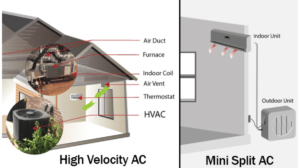As an HVAC business owner, you know that energy efficiency concerns are important for your customers, especially for people who want to live comfortably and conveniently, whether they reside in a place with cold weather or a warm location. You may know that for many people, the kind of heating and cooling or HVAC system that they use has the most significant impact on how comfy they are in their homes when the weather is extreme.
If your customers are tired of their conventional HVAC unit not working well, note that a high velocity HVAC system can be very beneficial for their homes. For this purpose, you must understand the benefits of a high velocity system so you can help your customers make the best decision. There are many benefits of small duct high velocity systems, especially in areas where houses are hundreds of years old with lots of historic detailing.
Did you know that small, high velocity-systems address many of the problems and issues that plague conventional systems? This gives homeowners an option that has several advantages. These systems are more energy-efficient, provide exceptional air quality, and are less obtrusive.
What is a High Velocity HVAC system?

You should know that a high velocity system is the re-engineered form of traditional HVAC systems that can create a faster flow of hot or cold air into a place. According to Energy Star, 20 percent to 30 percent of the air moving through residential ductwork is usually lost through holes, leaks, and poorly connected ducts. And this accounts for a considerable loss of energy.
Did you know that small or mini-duct HC systems are a lot more efficient? This is because the ducts in these HVAC systems are considerably smaller than conventional systems. So, there is significantly less surface area for energy loss. This new technology is also known as small-duct and can regulate any room temperature faster than the traditional air conditioning systems. It is worth noting that the smaller interior duct space helps create a faster airflow. Note that these high velocity HVAC systems may also be installed as a new HVAC option.
Like any regulated temperature management system in a living room or space, a high velocity HVAC system is used for monitoring. Also, these systems continually allow the flow of hot and cold air in and out of living space to control the temperature levels.
Did you know that traditional, low-velocity HVAC systems detect temperatures and gradually use diffusion to draw air from the vents? On the other hand, high velocity HVAC systems a process called aspiration. This process creates air currents that continually re-adjust the room temperature to match the desired temperature.
Also, it is worth noting that high velocity HVAC systems have considerably smaller air handlers. This makes it easier to fit them into tight spaces in any building. Because of their small ducts as well as insulated tubing, high velocity HVAC systems are highly energy-efficient, as well.
What is the Cost of high velocity Air Conditioning System for Your Customers?
Note that high velocity systems require special ductwork. As a result, their installation costs are usually higher than traditional heating and cooling systems. However, keep in mind that high velocity HVAC systems are an excellent choice in many homes. A high velocity unit cost can vary from $1800 to $2900, while installation costs are between $350 and $500.
Note that several factors affect the total cost of a high velocity HVAC system, and each of these factors can play an important role in the total cost. These are the main factors to take into consideration when pricing the installation of any high velocity HVAC system:
- In many cases, rural installation is much more affordable than the same service in a larger city.
- The number of units and size are also integral to the total cost.
- Noise level and quality of the system can play a role in the total cost.
- The time of year or weather can affect labor costs.
Note that for new construction, the high installation costs of these systems could be neglected. This is particularly true if you consider the significantly lower costs of maintenance and utility. Also, it is worth noting that high velocity systems experience 25 percent less leakage in the air ducts compared to conventional HVAC systems. And this means better utility, less energy consumption, and more efficiency.
How Does High Velocity Air Conditioning Work?

Did you know that, in principle, high velocity HVAC systems work in almost the same way as most traditional HVAC systems? A heat pump or compressor located outside the building supplies the heated or cool air, which moves through an efficient duct system to all rooms in a home.
However, note that this is where the similarities end. It is worth noting that high velocity HVAC systems rely on compact tubing to deliver conditioned air to various parts of the home. Keep in mind that this tubing is quite flexible and about two inches wide, while the vents are five inches in diameter. On the other hand, traditional ductwork is considerably wider.
A high velocity HVAC system operates quite similarly to a showerhead. Irrespective of the water pressure in the pipes, note that the showerhead’s small holes help produce a low velocity and high-pressure stream of water.
These systems have a unique feature that allows them to throw air with very high pressure. Note that the throwing speed is faster. As a result, the circulation of air increases several times compared to conventional HVAC systems. High velocity HVAC systems use considerably smaller ducts in the walls.
They are usually 50 percent smaller than conventional duct systems. This is why they have to use a high velocity system to produce the same output. Note that the high velocity air handler will pump the hot or cool air under high pressure to the vents. This is why your customers can cool or heat their home much faster if they have a high velocity system.
Benefits of high velocity HVAC Systems
1. Ease of Installation
High velocity systems are easier to install in older homes with no existing AC system. Keep in mind that at only 2 inches wide, the ducts in these units are much easier to retrofit compared to the standard 8-inch HVAC ducts.
Did you know that these miniature ducts can also run below floors, inside walls, and in many other tight spaces? All units in a high velocity system are versatile and flexible enough to be easily installed in any place, even closets, attics, and basements. And this is the reason high velocity HVAC systems are an excellent choice for retrofit.
2. Excellent Humidity Removal
Because of the high pressure of the air that comes out of the outlets in most high velocity HVAC systems, it is possible to reduce the humidity level by 30 percent.
3. Improved Aesthetics
It is worth noting that the smaller vents of high velocity systems are less noticeable. This is why they can be easily tucked away out of sight. So, many homeowners like high velocity systems for this reason.
4. Quiet Operation
There is no doubt that noise pollution is a significant issue with some small units, especially window units. While large, low velocity HVAC units can also be quite noisy, small, high velocity units are typically quiet. Did you know that the mini ducts in these systems are individually insulated to reduce noise? There is no need for your customers to turn up the TV volume when a high velocity HVAC unit is running.
5. Suitable for New homes that have Radiant Floor Heating
Keep in mind that these homes do not need bulky heating ductwork. As a result, the smaller high velocity systems are an excellent cooling option.
6. More Efficient Cooling
As their name suggests, a high velocity system typically makes a room colder faster, and it uses half the airflow to achieve this. They remove about 30 percent more moisture than traditional systems, a compelling selling point in humid and hot climates.
7. Even Temperatures
Your customers will enjoy even temperatures in each room. This is because of the circulation system as well as high velocity air. Note that the mini ducts in the system allow the air to enter the space with four times more pressure, so the room temperature is managed.
Final Thoughts
Besides absorbing sound for a quieter operation, high velocity HVAC systems deliver uniform temperature air without creating any drafts. They are also more energy-efficient and simple to install. Your HVAC company is likely a local business, and typically, customers search for local contractors. This is why you should leverage Google Business Profile to grow your business. Use these tips to collect more reviews for your HVAC business on Google Business Profile. You can also use Podium to improve your overall customer experience with sentiment analysis, reviews, messaging tools, Webchat, and a lot more.



